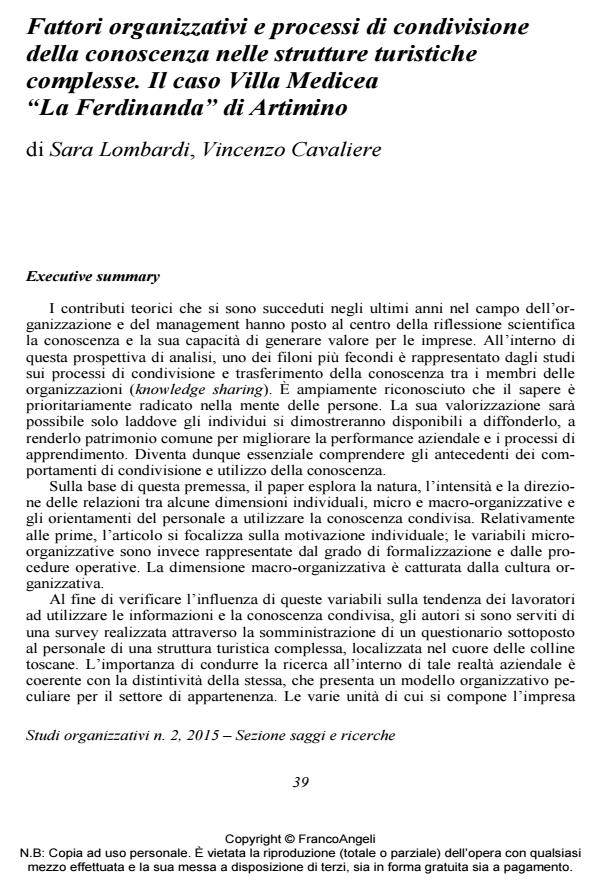Fattori organizzativi e processi di condivisione della conoscenza nelle strutture turistiche complesse. Il caso Villa Medicea "La Ferdinanda" di Artimino
Journal title STUDI ORGANIZZATIVI
Author/s Sara Lombardi, Vincenzo Cavaliere
Publishing Year 2016 Issue 2015/2
Language Italian Pages 35 P. 39-73 File size 305 KB
DOI 10.3280/SO2015-002002
DOI is like a bar code for intellectual property: to have more infomation
click here
Below, you can see the article first page
If you want to buy this article in PDF format, you can do it, following the instructions to buy download credits

FrancoAngeli is member of Publishers International Linking Association, Inc (PILA), a not-for-profit association which run the CrossRef service enabling links to and from online scholarly content.
Over the last decades, organization studies have been inspired by the knowledge-based view, which points to the importance of knowledge assets for firms’ competitiveness. At the core of this stream is the awareness that knowledge should flow across the whole organization. Given that ideas and know-how are rooted in individuals’ minds, for such knowledge to be valuable, it is fundamental to share and use it. Therefore, it becomes vital to understand the antecedents to knowledge sharing and utilization behaviours. This paper focuses on the role of individual, micro and macroorganizational factors in affecting employees’ knowledge utilization. Specifically, it centres on individual motivation, job formalization and operating procedures, and organizational culture and tests the related hypotheses in a complex tourism organization. The results of a regression analysis demonstrate that people motivated by reputation enhancement are less likely to engage in using the shared knowledge. However, such negative relationship is mitigated by a community organizational culture, which emphasizes social cohesion, teamwork, and commitment. Finally, the data show that while formalization is positively associated with knowledge utilization behaviours, operating procedures tend to inhibit them. Accordingly, this study suggests practical implications managers can rely on when designing their strategies for fostering employees’ participation and involvement in knowledge exploitation processes.
Keywords: knowledge sharing, motivation, community culture, formalization, operating procedures, tourism management
Sara Lombardi, Vincenzo Cavaliere, Fattori organizzativi e processi di condivisione della conoscenza nelle strutture turistiche complesse. Il caso Villa Medicea "La Ferdinanda" di Artimino in "STUDI ORGANIZZATIVI " 2/2015, pp 39-73, DOI: 10.3280/SO2015-002002